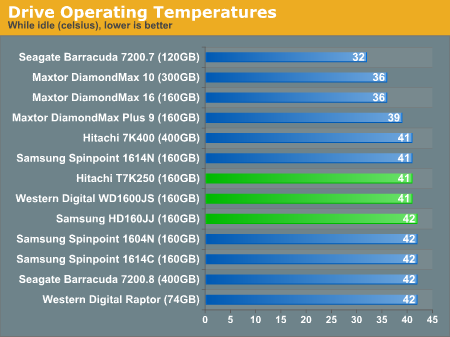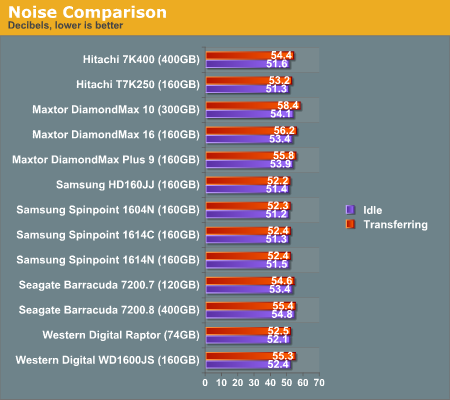SATA II to the Power of 3.0Gb/sec: Three Drives Reviewed
by Purav Sanghani on June 25, 2005 7:06 PM EST- Posted in
- Storage
Thermal and Acoustics
Heat and sound are also two very important factors in drive performance especially when considering where they will be used. A loud hard drive which becomes warm very quickly may not be the best choice for home theater PCs or any PC without adequate cooling and the noise alone could be a bit annoying. Take a look at how each drive performed as far as heat and noise output goes.
Thermal
Temperature readings are taken directly off of the hard disk drives topside above the platters.

The overall idle temperatures of each drive are not extremely high lingering at about 41-42 degrees celsius. But...

...when comparing them to each drive's operating temperatures, they come close to being the warmest running drives on the list at 47-48 degrees, at the same heat level as the 10,000RPM Raptor and 16MB DiamondMax 10..
Acoustics
To measure the sound output of each drive we have taken decibel readings of each drive at their startup phase as well as the sound output while there is disk activity.

Sound output is never an issue if a high quality sealed case is used to house the PC's components but it can get annoying with a few hard disks churning away. Each of the SATA300 drives produced a reasonable amount of noise, not really as quiet as the SATA150 SpinPoint series, but nowhere as loud as Maxtor's DiamondMax 10.










52 Comments
View All Comments
fbottone - Sunday, June 26, 2005 - link
Hows about adding a Maxtor SATAII (like Maxline III 300GB) drive to the mix? The SATA-I maxtors do pretty well in certain tests but I'd like to see them compared with the three very good drives already there.BornStar18 - Sunday, June 26, 2005 - link
I'm confused by your conclusion on page 5 regarding Office Productivity. Your written statement doesn't support what I'm looking at in the graph. Does the text not refer to graph?100proof - Sunday, June 26, 2005 - link
Would it be possible to get an update to this review showcasing some of the real benefits of SATA II?It seems pointless to test these drives individually as it's fairly obvious drives set at the 7200rpm speed will not improve much for indivdual performance.. Raid Arrays are necessary to guage how much of a performance boost the added bw of SATA300 factors into results. It would also be nice to see comparisons of these new SATA II drives in raid set against similar setups of SATA 150/ATA raid arrays. This might be asking too much though...
olly - Sunday, June 26, 2005 - link
When you select "Print this article", page 3 onwards the font is too big.Svenna - Sunday, June 26, 2005 - link
There is actually no good SATA NCQ conrollers around for the for the amd platform, yet. IMO only the new AHCI controller would be worth testing ncq on :(Aenslead - Sunday, June 26, 2005 - link
bah... what a fiasco.Googer - Sunday, June 26, 2005 - link
I think this says it all, Raptors are almost extinct. They need to be updated or they will die.The performance they show is poor when compaired to the latest 7200 drives.
greekfragma - Sunday, June 26, 2005 - link
couldnt agree more with zax7480.gyuz can u tell us what was wrong with nvidia driver package 6.54 and u tested with a driver that was publiced one year ago ?
plus i like your comment at final words of the article
'' In time, however, we should see improvements in drivers to help reach the true potentials for the new SATA standard.''
thumbs down for this review
jax7480 - Sunday, June 26, 2005 - link
I would like to know the reason that make them install such and OLD driver for the Nvidia chipset. Driver 6.39 was released February 2004. This was the first chipset driver for Nforce 4. It was released together with Nforce 4 chipset.Couldn't they just DOWNLOAD a newer one? We are talking about NEW HDD drives here.
cryptonomicon - Sunday, June 26, 2005 - link
hmm, i liked this review alot because i can see the performance of alot of common drives on the market today and see their performance in comparison to each other, regardless to what SATA2 is doing.